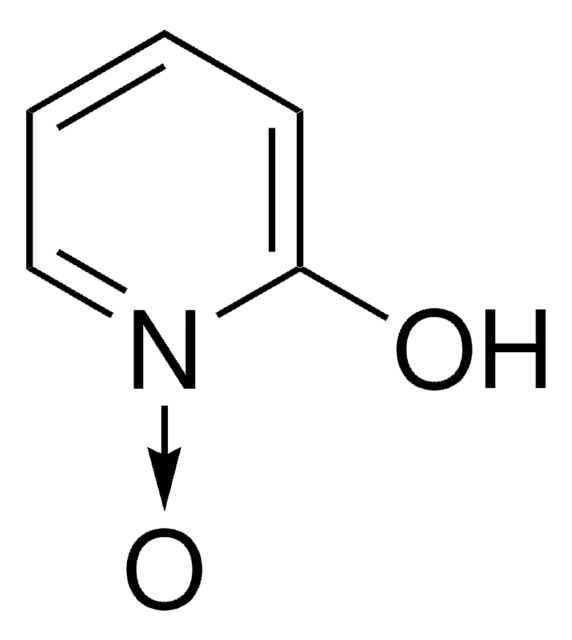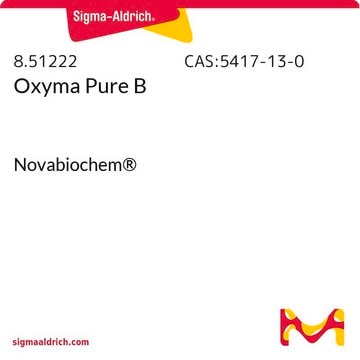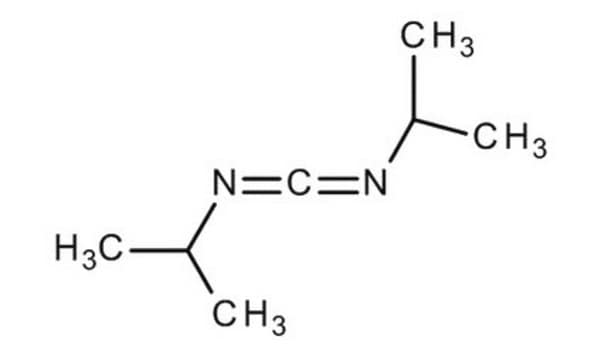233412
Ethyl (hydroxyimino)cyanoacetate
97%, for peptide synthesis
Synonym(s):
Ethyl cyano(hydroxyimino)acetate, Ethyl cyanoglyoxalate-2-oxime, Ethyl isonitrosocyanoacetate
Sign Into View Organizational & Contract Pricing
All Photos(1)
About This Item
Linear Formula:
NCC(=NOH)CO2C2H5
CAS Number:
Molecular Weight:
142.11
Beilstein:
774783
EC Number:
MDL number:
UNSPSC Code:
12352100
PubChem Substance ID:
NACRES:
NA.22
Recommended Products
Product Name
Ethyl (hydroxyimino)cyanoacetate, 97%
Quality Level
Assay
97%
form
solid
mp
130-132 °C (lit.)
application(s)
peptide synthesis
functional group
amine
ester
nitrile
oxime
SMILES string
CCOC(=O)C(=N\O)\C#N
InChI
1S/C5H6N2O3/c1-2-10-5(8)4(3-6)7-9/h9H,2H2,1H3/b7-4+
InChI key
LCFXLZAXGXOXAP-QPJJXVBHSA-N
Looking for similar products? Visit Product Comparison Guide
General description
Ethyl (hydroxyimino)cyanoacetate is a potential replacement for zobenzotriazole and benzotriazole derivatives used in peptide synthesis.
Ethyl (hydroxyimino)cyanoacetate is also called as Oxyma. It is a highly efficient greener alternative for the amide and peptide synthesis.
Ethyl (hydroxyimino)cyanoacetate is also called as Oxyma. It is a highly efficient greener alternative for the amide and peptide synthesis.
Application
Ethyl (hydroxyimino)cyanoacetate has been used as an additive for the carbodiimide-mediated amide bond formation during established peptide synthesis method.For peptide synthesis grade material, please see product 851086.
Storage Class Code
11 - Combustible Solids
WGK
WGK 3
Flash Point(F)
Not applicable
Flash Point(C)
Not applicable
Personal Protective Equipment
dust mask type N95 (US), Eyeshields, Gloves
Choose from one of the most recent versions:
Already Own This Product?
Find documentation for the products that you have recently purchased in the Document Library.
Customers Also Viewed
Alvin W Hung et al.
Proceedings of the National Academy of Sciences of the United States of America, 108(17), 6799-6804 (2011-04-13)
Fragment-based drug discovery (FBDD) has proven to be an effective means of producing high-quality chemical ligands as starting points for drug-discovery pursuits. The increasing number of clinical candidate drugs developed using FBDD approaches is a testament of the efficacy of
Doaa M Anwar et al.
Bioconjugate chemistry, 29(9), 3026-3041 (2018-08-16)
In this study, promising approaches of dual-targeted micelles and drug-polymer conjugation were combined to enable injection of poorly soluble anticancer drugs together with site-specific drug release. Ursodeoxycholic acid (UDCA) as a hepatoprotective agent was grafted to maltodextrin (MD) via carbodiimide
Minimizing HCN in DIC/Oxyma-mediated amide bond-forming reactions
Erny, Marion and Lundqvist, et al.
Organic Process Research & Development, 24, 1341-1349 (2020)
Hangyu Zhang et al.
Acta biomaterialia, 55, 183-193 (2017-04-04)
Self-assembling peptides programed by sequence design to form predefined nanostructures are useful for a variety of biomedical applications. However, assemblies of classic ionic self-complementary peptides are unstable in neutral pH, while charged peptide hydrogels have low mechanical strength. Here, we
Daniele Maiolo et al.
ChemistryOpen, 9(2), 253-260 (2020-02-29)
Here, we demonstrate that introduction of halogen atoms at the tyrosine 10 phenol ring of the DSGYEV sequence derived from the flexible amyloid-β N-terminus, promotes its self-assembly in the solid state. In particular, we report the crystal structures of two halogen-modified
Our team of scientists has experience in all areas of research including Life Science, Material Science, Chemical Synthesis, Chromatography, Analytical and many others.
Contact Technical Service










![COMU 1-[(1-(Cyano-2-ethoxy-2-oxoethylideneaminooxy) dimethylaminomorpholino)] uronium hexafluorophosphate Novabiochem®](/deepweb/assets/sigmaaldrich/product/images/237/337/13566c06-8931-4cc2-8621-c8742a392cd6/640/13566c06-8931-4cc2-8621-c8742a392cd6.jpg)

